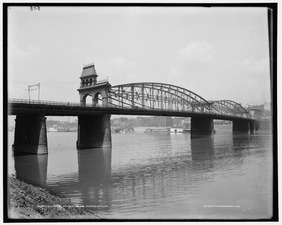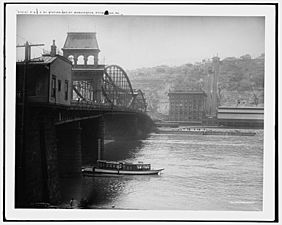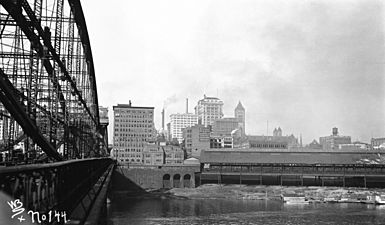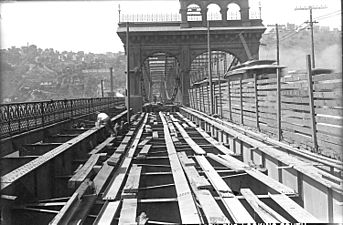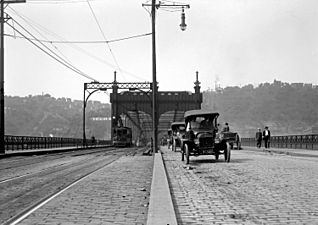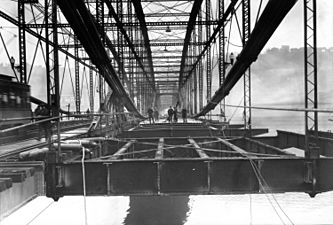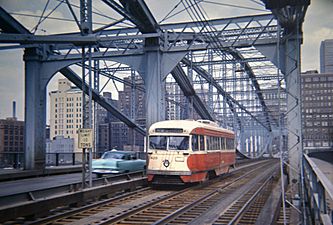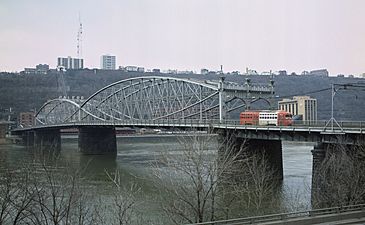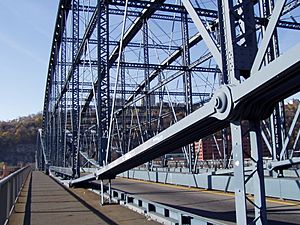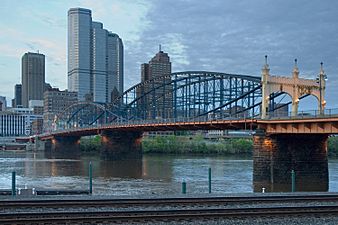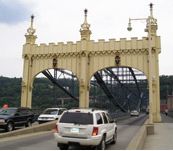Smithfield Street Bridge facts for kids
Quick facts for kids Smithfield Street Bridge |
|
|---|---|
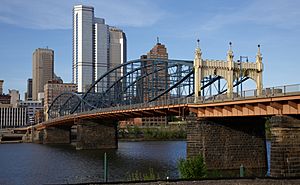
Smithfield Street Bridge
|
|
| Coordinates | 40°26′5″N 80°0′8″W / 40.43472°N 80.00222°W |
| Carries | 4 lanes of roadway 2 pedestrian walkways |
| Crosses | Monongahela River |
| Locale | Pittsburgh, Pennsylvania |
| Characteristics | |
| Design | Lenticular truss bridge |
| Total length | 1,184 feet (361 m) |
| Longest span | 2 spans, 360 feet (110 m) each |
| Clearance below | 42.5 feet (13.0 m) |
| History | |
| Opened | March 19, 1883 |
|
Smithfield Street Bridge
|
|
| Area | 1 acre (0.40 ha) |
| Architect | Gustav Lindenthal |
| Architectural style | Romanesque, Pauli truss |
| NRHP reference No. | 74001745 |
| Significant dates | |
| Added to NRHP | March 21, 1974 |
| Designated NHL | May 11, 1976 |
The Smithfield Street Bridge is a very old and important bridge in Pittsburgh, Pennsylvania, USA. It crosses the Monongahela River. This bridge is special because it's a "lenticular truss bridge". This means its main parts have a unique, eye-shaped design. It was designed by a famous engineer named Gustav Lindenthal. He also designed the huge Hell Gate Bridge in New York City. The Smithfield Street Bridge opened way back on March 19, 1883. It has been recognized as a National Historic Civil Engineering Landmark and a National Historic Landmark.
Contents
History of the Bridge
Earlier Bridges at This Spot
The Smithfield Street Bridge you see today is actually the third bridge built in this exact spot. It's also one of the oldest steel bridges still standing in the United States!
- First Bridge: In 1818, a wooden bridge was built here by Louis Wernwag. It cost about $102,000, which was a lot of money back then! Sadly, this bridge was destroyed in the Great Fire of Pittsburgh in 1845.
- Second Bridge: After the fire, a new bridge was built. It was a "wire rope suspension bridge" designed by John A. Roebling. He was famous for building bridges with strong wire cables. But as more people and cars used the bridge, and more boats traveled on the river, this bridge became too small and weak.
Building the Current Bridge
So, the current Smithfield Street Bridge was built to replace the second one. It even used the strong stone foundations (piers) that Roebling's bridge had. This new bridge was built between 1881 and 1883.
The Smithfield Street Bridge is one of the last bridges you cross on the Monongahela River before it meets the Allegheny River. Together, these two rivers form the Ohio River right in Downtown Pittsburgh. Only the Fort Pitt Bridge is closer to where the rivers meet.
Bridge Changes Over Time
The bridge was made wider twice, first in 1889 and again in 1911. For many years, it also carried Pittsburgh Railways streetcar lines. These streetcars traveled from the Mt. Washington Transit Tunnel and Carson Street, crossed the bridge, and went into downtown Pittsburgh. The streetcar tracks were on the eastern side of the bridge.
In July 1985, the streetcar lines changed. They started using the Panhandle Bridge and a new light rail subway system instead. The very last streetcar crossed the Smithfield Street Bridge early in the morning on July 7, 1985. After that, the old streetcar tracks were removed. That part of the bridge became an extra lane for cars going north.
A Special Bridge
The Smithfield Street Bridge is very important historically.
- It was added to the National Register of Historic Places on March 21, 1974.
- Two years later, on May 11, 1976, it was named a National Historic Landmark. This means it's recognized as a place of national historical importance.
At one point, some officials thought about tearing down the bridge because it was getting old and sat low over the river. But the Pittsburgh History and Landmarks Foundation worked hard to save it. They showed how important and special the bridge was.
Because of these efforts, the bridge was fixed up in 1994–1995. It got a new road surface, a fresh coat of colorful paint, and cool lights that make it look amazing at night. The old streetcar lines became an extra traffic lane. They even added a special bus lane that can be turned on during busy times.
Today, the Smithfield Street Bridge is also known for being the bridge most used by people walking. Many commuters who park at Station Square walk across it to get to Downtown Pittsburgh. The bridge connects Smithfield Street in Downtown Pittsburgh with Station Square.
Images for kids
-
View from downtown in 1984, with a streetcar leaving the bridge




